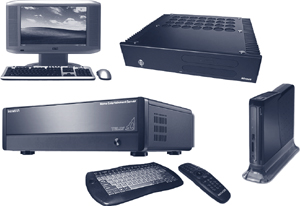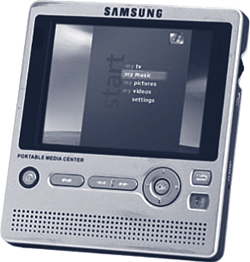Suffice it to say that WMC machines have considerable hardware requirements. At the very least, a WMC machine has the following:
A
remote infrared (IR) sensor that enables the remote control to
communicate with the computer and that also controls the cable or
satellite set-top box
A fast graphics card for smoothly displaying moving images such as video and TV playback
A TV tuner that captures the television signal from a cable, satellite, or HDTV antenna source
A
hardware encoder that enables you to record TV shows from cable,
satellite, or HDTV antenna to your computer’s hard disk in real time
A TV output jack so that you can display WMC content on a TV connected to your computer
A digital audio output that allows you to integrate digital audio from your computer into an existing home-entertainment system
You can read about Windows Media Center feature set and related information at www.microsoft.com/windows/windows-media-center/default.aspx.
|
WMC
is not limited to watching, or recording, TV in standard-definition TV
(SDTV) format. HDTV shows, movies, and DVDs can also be watched or
recorded on your computer. Unfortunately, you need different hardware
to do so than the average WMC computer has available. So, just what
will you need to achieve your goal of watching HD video? Well, at a
minimum consider the following:
An HD input source—
This can be a cable box, satellite (I have a Hughes HR10-250 with
DirectTV HD programming and TiVo software for DVR), or broadcast (over
the airwaves) TV with an output your computer TV tuner can use as an
HDTV input source. A hybrid HDTV tuner can tune
and record only one signal (either analog or digital) at any given
time. Combo HDTV tuners for the PC can perform both simultaneously.
Tuners with High-Definition Multimedia Interface (HDMI), Digital Video
Interface (DVI), or YPbPr (analog video signal carried by component
video cables) aren’t far away, in my opinion. An HDTV tuner for your computer—
If you are purchasing a new Windows 7 computer with WMC, make sure it
has an HDTV-compatible tuner. If you are upgrading your existing
computer or building your own, look for a new tuner with HD
capabilities built in. A powerful video card—
Video memory is used during the overlay process to display the output
from your TV tuner. HDTV requires more video memory (than SDTV) to
display on your monitor without losing frames. Look for a video card
with a minimum of 128MB, with 256MB recommended and 512MB preferred if
you plan to use multiple output monitors. A vast amount of storage—
HD video requires an enormous amount of disk storage. Video compression
is also a requirement to lower the storage needs to a reasonable,
cost-effective solution. To give you an idea for comparison, my TiVo
box that uses MPEG-2 video compression and has 500GB of storage can
record 515 hours of SDTV but only 77 hours of HDTV. Luckily, terabyte
disk drives have recently become available at reasonable cost. An HDTV display—
Although you can watch HDTV on your computer, you really will not get
the most out of it without an HDTV display of 40 inches or more to view
your HDTV shows. A reasonable budget—
External terabyte disk drives as of this writing cost under $200 for a
bare-bones model. Internal drives are available, and you can expect to
pay a premium for them. Video cards with 512MB of video memory cost a
few hundred dollars. The cost of HDTV displays, fast processors, fast
RAM, and so on, all add up.
|
The New WMC PC Form Factors
As
of this writing, no brand-name manufacturers provide complete
ready-to-run systems running Windows 7 Media Center.If it meets the minimum requirements for Windows 7 Home
Premium, Professional, or Ultimate, it should be upgradable to the
latest edition of WMC.
WMC PCs come in a
wide variety of form factors that push the outside of the envelope of
what we call a PC. They range from boxes that look much like PCs to
those that most definitely do not. Figure 1
shows an example of several WMC PCs. As you can see, there’s a trend to
blend the look of the PC with home-entertainment gear such as a stereo
receiver. This is becoming the preferred form factor for audiophile
types who don’t want their WMC machine to take up a lot of space or to
look like a computer. This design also allows the computer to be
rack-mounted or stacked with other A/V gear.

Due
to the miniaturization of large hard disk storage, proliferation DVD
writers, and availability bright wide-screen LCDs, another class of
WMC-based computer has recently emerged: portables. These power-packed
portable entertainment systems come in three flavors—a laptop computer
on steroids, a Tablet PC, and a small, dedicated playback-only WMC
machine. Figure 2
shows a small, dedicated WMC portable tablet device from Samsung. The
Qosmio has a TV tuner card in it. However, some WMC laptops do not
record TV, owing to the lack of a TV tuner card. Virtually all the
small, portable WMC tablet-format devices are playback-only devices as
well.

As of this writing, you can find some information about WMC PC hardware at www.microsoft.com/windows/windows-media-center/get-hardware.aspx.
Is Windows Media Center Based on Home or Business Versions?
Good
question. I’ve had some debate with friends and colleagues about this.
Media Center Edition (MCE) 2004 was based on Windows XP Professional.
It included the capability to join a domain and encrypt the file
system. When MCE 2005 came out, these features were no longer
available, indicating that the 2005 version was based on the Home
version of XP. This inability to join a domain handicapped business
users and indicated that Microsoft’s primary focus for MCE was the home
user. That decision must have generated a lot of negative feedback to
Microsoft because the current version of MCE is included in a home
version (Windows 7 Home Premium) and a business-capable version
(Windows 7 Professional and Ultimate).